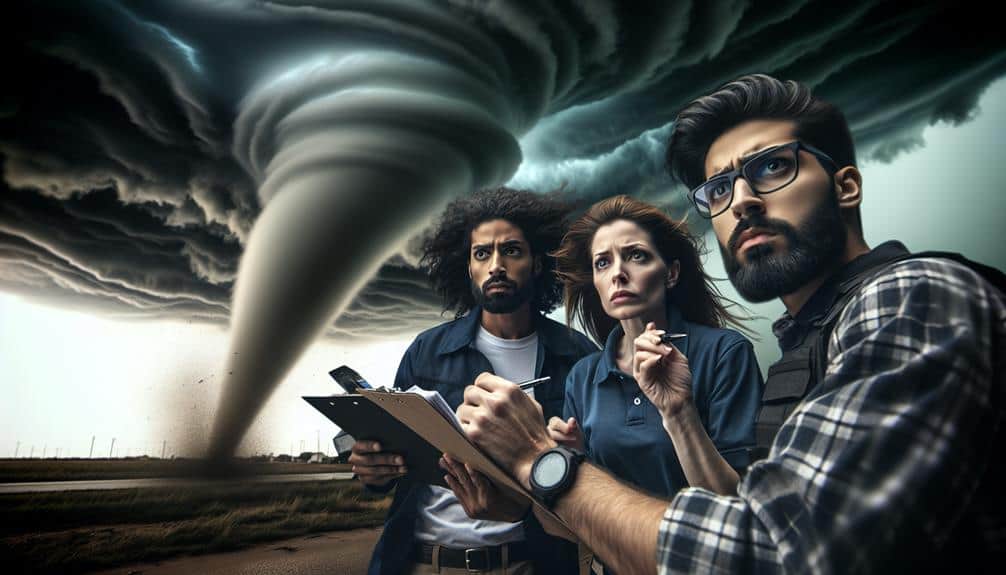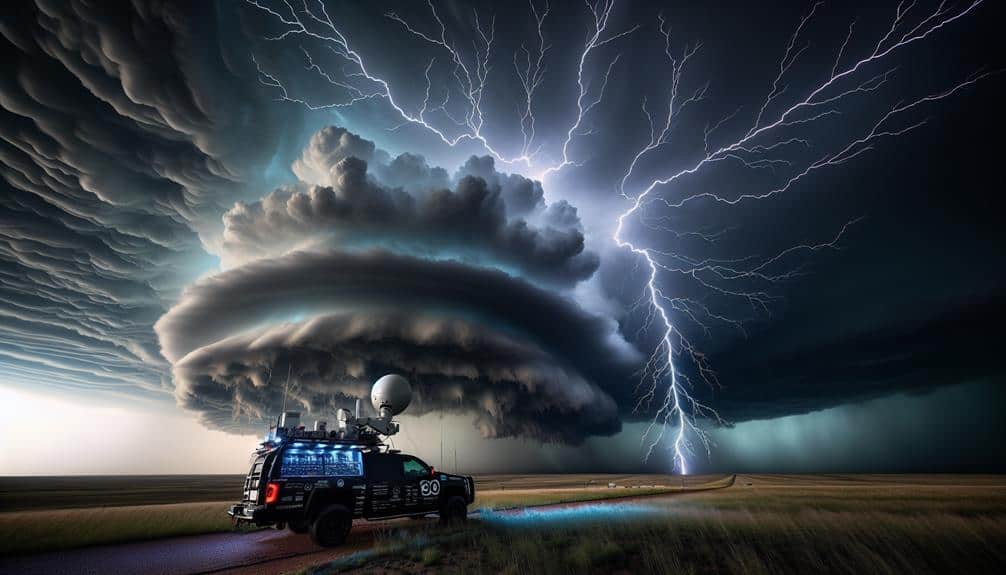We prioritize ethical conduct while chasing storms by focusing on cultural awareness and following local emergency protocols. We reduce our environmental impact through fuel-efficient vehicles and principles that leave no trace. Safety is key, necessitating in-depth risk assessments and continuous monitoring. Our data integrity depends on strong verification processes and transparent sharing of methodology. Working together enhances our work, allowing for effective resource allocation and public education. By following these practices, we show respect for communities, safeguard the environment, and maintain scientific rigor. For a more thorough understanding, additional exploration will offer deeper insights.
Key Points
- Prioritize cultural sensitivity and respect local customs and communities.
- Conduct thorough risk assessments and establish clear safety and evacuation protocols.
- Minimize environmental footprint by using fuel-efficient vehicles and practicing leave-no-trace principles.
- Ensure data integrity and transparency by sharing methodologies and undergoing rigorous ethics training.
Respecting Local Communities
When storm chasing, we must prioritize respecting local communities to minimize disruptions and maintain positive relationships. This involves a high level of cultural awareness, as each community has its own unique norms and values. We should endeavor to understand these nuances to avoid inadvertently causing offense or harm.
For instance, some areas may have specific protocols for emergency situations that we need to adhere to, ensuring our actions align with local expectations.
Community engagement is another critical aspect. Engaging with local residents can provide valuable insights into the area's specific weather patterns and historical context. This not only aids our storm-chasing efforts but also fosters goodwill. By building relationships with locals, we can create a network of informed individuals who can offer real-time information and assistance when needed.
Moreover, we must be mindful of our environmental footprint. This means minimizing litter and avoiding actions that could damage local infrastructure or natural landscapes. Essentially, our presence should be as non-intrusive as possible.
Prioritizing Safety
Ensuring our safety during storm chasing requires thorough preparation and adherence to established protocols. We must conduct comprehensive risk assessments before commencing any storm chase. This involves analyzing weather data, understanding storm patterns, and identifying potential hazards. By systematically evaluating these factors, we can make informed decisions on when and where to pursue storms, minimizing unnecessary exposure to danger.
Emergency protocols are indispensable. We need to establish clear communication channels and designate roles within our team to guarantee everyone knows their responsibilities. Having a well-defined evacuation plan is vital. This plan should include multiple exit routes, pre-determined safe zones, and contingency measures for varying scenarios. Additionally, our vehicles must be equipped with emergency supplies, such as first aid kits, water, and communication devices, to handle unforeseen circumstances efficiently.
We must also prioritize real-time monitoring. Utilizing advanced radar systems and GPS tracking allows us to stay updated on storm developments and adjust our strategies accordingly. By consistently applying these safety measures, we not only protect ourselves but also enhance the overall integrity of our storm-chasing endeavors.
Freedom to chase storms comes with the responsibility to prioritize safety through meticulous preparation and constant vigilance.
Environmental Responsibility
While chasing storms, we must consider the environmental impact of our activities to safeguard we don't unintentionally harm the ecosystems we study. Our quest for understanding shouldn't come at the expense of the natural world. To balance our scientific pursuits with ecological stewardship, we need to adopt sustainable practices and prioritize conservation efforts.
We can take several measures to minimize our environmental footprint:
- Utilize fuel-efficient vehicles: Reducing fuel consumption helps lower carbon emissions, aligning with eco-friendly solutions.
- Minimize waste: Properly disposing of or recycling materials used during expeditions prevents pollution.
- Respect wildlife habitats: Avoiding disruption to local fauna ensures the preservation of biodiversity.
- Use renewable energy sources: Implementing solar or wind power for equipment reduces reliance on fossil fuels.
Data Integrity
Maintaining data integrity is important in storm chasing to make certain our research findings are reliable and valid. To achieve this, we need rigorous ethics training that emphasizes honesty and accuracy in data collection and analysis. This training helps us grasp the significance of each piece of data we collect and the impact of our interpretations on the broader scientific community.
Research transparency is another critical component. Openly sharing our methodologies, data sets, and analytical processes allows others to verify our results and build upon our work. This transparency fosters trust and collaboration within the meteorological community, ensuring that our findings contribute meaningfully to the field.
Moreover, we must implement robust data verification processes. This includes cross-checking data points, validating instruments, and conducting peer reviews. By doing so, we minimize errors and uphold the highest standards of scientific rigor.
Ultimately, upholding data integrity isn't just about adhering to ethical guidelines; it's about preserving the freedom to explore and comprehend nature's most powerful phenomena without compromising scientific credibility. Through meticulous ethics training and unwavering research transparency, we guarantee our storm chasing endeavors yield trustworthy and impactful results.
Collaborative Efforts

Building upon our commitment to data integrity, collaborative efforts among storm chasers enhance the accuracy and thoroughness of our research. By pooling our resources and expertise, we can guarantee that our findings are robust, reliable, and ethically sound.
Community engagement is central to this approach, fostering a network of dedicated individuals who share a passion for meteorology and a dedication to ethical standards.
To illustrate the benefits of collaborative efforts, consider the following:
- Data Sharing: By exchanging real-time data, we can cross-verify observations and improve the precision of our analyses.
- Resource Allocation: Joint efforts allow for the efficient use of equipment and technology, maximizing the utility of available resources.
- Safety Protocols: Collaborating enables us to establish and adhere to thorough safety protocols, ensuring the well-being of all participants.
- Training and Education: Engaging with the community provides opportunities to train new storm chasers, promoting best practices and ethical standards.
Frequently Asked Questions
What Qualifications Are Required to Become a Professional Storm Chaser?
To become professional storm chasers, we need extensive meteorological knowledge and significant field experience. Our expertise in weather patterns and hands-on skills guarantee we can safely and effectively study severe weather phenomena while maintaining our freedom.
How Can Storm Chasers Secure Funding for Their Expeditions?
We can obtain funding for our expeditions through crowdfunding campaigns and sponsorship opportunities. Additionally, we can pursue research grants and establish academic partnerships to support our scientific endeavors and guarantee the necessary financial resources.
What Equipment Is Essential for Storm Chasing?
We need essential equipment like weather radars, GPS systems, and sturdy vehicles to chase storms effectively. Incorporating safety measures and leveraging technology advancements guarantees we can pursue our passion while minimizing risks and optimizing data collection.
How Do Storm Chasers Communicate With Meteorological Agencies?
We adhere to communication protocols with meteorologists to enhance forecast accuracy. Our storm chasers relay real-time data via radio, satellite, and digital networks, ensuring rapid updates and collaborative efforts for precise and effective storm tracking.
Can Storm Chasing Be a Full-Time Career?
Yes, storm chasing can be a full-time career, but career stability and job satisfaction vary. While the adventure lifestyle is appealing, financial risks are significant. It's important to weigh stability against the excitement of the profession.


